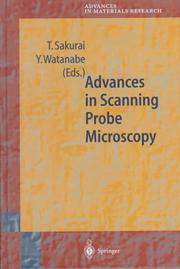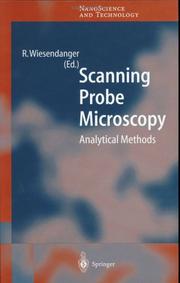| Listing 1 - 10 of 122 | << page >> |
Sort by
|

Abstract | Keywords | Export | Availability | Bookmark
 Loading...
Loading...Choose an application
- Reference Manager
- EndNote
- RefWorks (Direct export to RefWorks)

ISBN: 3540638156 9783540638155 Year: 1998 Publisher: Berlin: Springer,
Abstract | Keywords | Export | Availability | Bookmark
 Loading...
Loading...Choose an application
- Reference Manager
- EndNote
- RefWorks (Direct export to RefWorks)
Book
ISBN: 1621980324 1283145154 9786613145154 9814324779 9789814324779 9789814324762 9814324760 Year: 2011 Publisher: Singapore Hackensack, NJ World Scientific Pub. Co.
Abstract | Keywords | Export | Availability | Bookmark
 Loading...
Loading...Choose an application
- Reference Manager
- EndNote
- RefWorks (Direct export to RefWorks)
Scanning Probe Microscopy (SPM) is the enabling tool for nano(bio)technology, which has opened new vistas in many interdisciplinary research areas. Concomitant with the developments in SPM instrumentation and techniques are new and previously unthought-of opportunities in materials nanofabrication and characterisation. In particular, the developments in addressing and manipulating matter at the level of single atoms or molecules, and studies of biological materials (e.g. live cells, or cell membranes) result in new and exciting discoveries. The rising importance of SPM demands a concise treatm
Book
Year: 2016 Publisher: London : InTechOpen,
Abstract | Keywords | Export | Availability | Bookmark
 Loading...
Loading...Choose an application
- Reference Manager
- EndNote
- RefWorks (Direct export to RefWorks)
Near-surface atmospheric measurements over urban or industrial areas aimed at assisting the air-quality monitoring attain increasing societal significance due to the strong and direct impact of aerosol pollutions in the low troposphere on the human health. In this chapter, we present experimental results on lidar mapping of aerosol fields over the city of Sofia (Bulgaria), its suburbs and adjacent towns and villages, obtained during an extensive 7-month experimental campaign in 2015. The measurements are conducted by scanning observation zones in horizontal and vertical directions using lidar systems developed at the Institute of Electronics, Bulgarian Academy of Sciences. Based on the aerosol backscattering profiles retrieved at different azimuth or elevation angles, two-dimensional color-coded sector maps of the near-surface aerosol density are obtained, overlaid on the topological map of the Sofia region. The analysis of the lidar maps shows good correlation between the aerosol density distribution and the locations of important sources of aerosol pollutions in the zones of observation, such as city streets with intense traffic, industrial facilities, densely populated residential districts, etc. The results reported demonstrate that aerosol lidar mapping could be regarded as an effective approach for accurate and reliable determination of the density, spatial distribution, and temporal dynamics of close-to-ground aerosols, covering broad urban areas. Possibilities of incorporating synergistically lidar mapping technologies into municipal air-quality monitoring systems are also discussed.
Book
Year: 2016 Publisher: London : InTechOpen,
Abstract | Keywords | Export | Availability | Bookmark
 Loading...
Loading...Choose an application
- Reference Manager
- EndNote
- RefWorks (Direct export to RefWorks)
Near-surface atmospheric measurements over urban or industrial areas aimed at assisting the air-quality monitoring attain increasing societal significance due to the strong and direct impact of aerosol pollutions in the low troposphere on the human health. In this chapter, we present experimental results on lidar mapping of aerosol fields over the city of Sofia (Bulgaria), its suburbs and adjacent towns and villages, obtained during an extensive 7-month experimental campaign in 2015. The measurements are conducted by scanning observation zones in horizontal and vertical directions using lidar systems developed at the Institute of Electronics, Bulgarian Academy of Sciences. Based on the aerosol backscattering profiles retrieved at different azimuth or elevation angles, two-dimensional color-coded sector maps of the near-surface aerosol density are obtained, overlaid on the topological map of the Sofia region. The analysis of the lidar maps shows good correlation between the aerosol density distribution and the locations of important sources of aerosol pollutions in the zones of observation, such as city streets with intense traffic, industrial facilities, densely populated residential districts, etc. The results reported demonstrate that aerosol lidar mapping could be regarded as an effective approach for accurate and reliable determination of the density, spatial distribution, and temporal dynamics of close-to-ground aerosols, covering broad urban areas. Possibilities of incorporating synergistically lidar mapping technologies into municipal air-quality monitoring systems are also discussed.
Book

ISBN: 079233406X 9401040273 9401100497 9780792334064 Year: 1995 Volume: 286
Abstract | Keywords | Export | Availability | Bookmark
 Loading...
Loading...Choose an application
- Reference Manager
- EndNote
- RefWorks (Direct export to RefWorks)
Scanning probe microscopy --- Congresses. --- Scanning probe microscopy - Congresses.
Book
ISBN: 0511524358 Year: 1994 Publisher: Cambridge : Cambridge University Press,
Abstract | Keywords | Export | Availability | Bookmark
 Loading...
Loading...Choose an application
- Reference Manager
- EndNote
- RefWorks (Direct export to RefWorks)
The investigation and manipulation of matter on the atomic scale have been revolutionised by scanning tunnelling microscopy and related scanning probe techniques. This book is the first to provide a clear and comprehensive introduction to this subject. Beginning with the theoretical background of scanning tunnelling microscopy, the design and instrumentation of practical STM and associated systems are described in detail, as are the applications of these techniques in fields such as condensed matter physics, chemistry, biology, and nanotechnology. Containing 350 illustrations, and over 1200 references, this unique book represents an ideal introduction to the subject for final-year undergraduates in physics or materials science. It will also be invaluable to graduate students and researchers in any branch of science where scanning probe techniques are used.
Book
Year: 2005 Publisher: [Place of publication not identified] : KIT Scientific Publishing,
Abstract | Keywords | Export | Availability | Bookmark
 Loading...
Loading...Choose an application
- Reference Manager
- EndNote
- RefWorks (Direct export to RefWorks)
In der vorliegenden Arbeit wurde ein elektrochemisches Raster-Sonden-Mikroskop dazu benutzt, gezielt Nanostrukturen herzustellen und zu charakterisieren. Das elektrochemische Umfeld bietet gegenüber den sonst angewandten Techniken den Vorteil, dass die Über- und Untersättigung an den beiden Arbeitselektroden frei eingestellt werden kann. Diese Methode erlaubt es lokal Nanostrukturen definierter Größe herzustellen. Mittels einer selbst aufgebauten UHV-Apparatur konnten Präparationstechniken zur reproduzierbaren Herstellung von geometrisch hoch definierten STM-Spitzen für nahezu jedes Metall entwickelt werden. Derart qualitativ hochwertige STM-Spitzen ermöglichten erstmals einen Strommessbereich von 10-6 bis10-12 Ampere abzudecken. Die entwickelten Instrumente konnten zur Untersuchung der Systeme Co bzw. Ni auf Au(111)-Substraten eingesetzt werden. Das Verfahren zur Erzeugung magnetischer Nanostrukturen wurde optimiert und erste spektroskopische Messungen an der Fest-/ Flüssiggrenzfläche konnten durchgeführt werden.
Scanning tunneling microscopy. --- Scanning probe microscopy.
Book
Year: 2019 Publisher: Karlsruhe : KIT Scientific Publishing,
Abstract | Keywords | Export | Availability | Bookmark
 Loading...
Loading...Choose an application
- Reference Manager
- EndNote
- RefWorks (Direct export to RefWorks)
Magnetic molecules have attracted lots of interest. In this work, an ultra-stable and low noise scanning tunneling microscopy operating at 400 mK using He-3 (930 mK using He-4) has been developed. The magnetic behavior of different magnetic molecules on substrates, especially the exchange interaction between the magnetic ions, the magnetic anisotropy on the surface, the magnetic excitations as well as the Kondo effect, were studied by using STM.
Scanning tunneling microscopy. --- Scanning probe microscopy.
Book
Year: 2005 Publisher: [Place of publication not identified] : KIT Scientific Publishing,
Abstract | Keywords | Export | Availability | Bookmark
 Loading...
Loading...Choose an application
- Reference Manager
- EndNote
- RefWorks (Direct export to RefWorks)
In der vorliegenden Arbeit wurde ein elektrochemisches Raster-Sonden-Mikroskop dazu benutzt, gezielt Nanostrukturen herzustellen und zu charakterisieren. Das elektrochemische Umfeld bietet gegenüber den sonst angewandten Techniken den Vorteil, dass die Über- und Untersättigung an den beiden Arbeitselektroden frei eingestellt werden kann. Diese Methode erlaubt es lokal Nanostrukturen definierter Größe herzustellen. Mittels einer selbst aufgebauten UHV-Apparatur konnten Präparationstechniken zur reproduzierbaren Herstellung von geometrisch hoch definierten STM-Spitzen für nahezu jedes Metall entwickelt werden. Derart qualitativ hochwertige STM-Spitzen ermöglichten erstmals einen Strommessbereich von 10-6 bis10-12 Ampere abzudecken. Die entwickelten Instrumente konnten zur Untersuchung der Systeme Co bzw. Ni auf Au(111)-Substraten eingesetzt werden. Das Verfahren zur Erzeugung magnetischer Nanostrukturen wurde optimiert und erste spektroskopische Messungen an der Fest-/ Flüssiggrenzfläche konnten durchgeführt werden.
Scanning tunneling microscopy. --- Scanning probe microscopy.
| Listing 1 - 10 of 122 | << page >> |
Sort by
|

 Search
Search Feedback
Feedback About
About Help
Help News
News